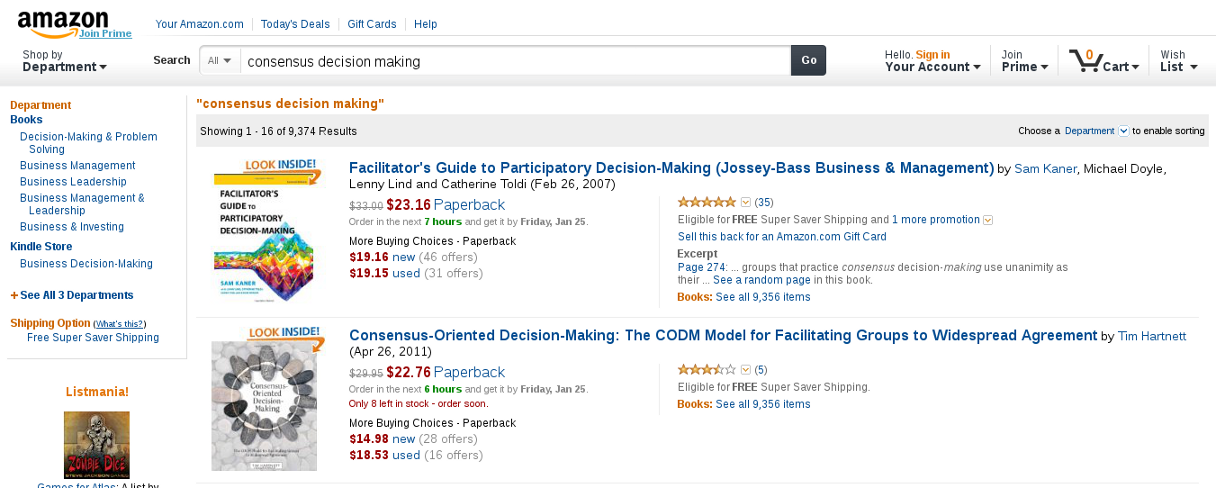User:Eleanorg/thesis/conflictInConsensus
Search for 'Consensus Decision Making' on Amazon and consider the first two results (Amazon.com, 2013). One: Facilitator's Guide to Participatory Decision-Making. I first encountered this book on my lunch break while working as a facilitator at an activist charity. It is a familiar face on the bookshelves of friends and like-minded folk - a bible perhaps, outlining the process of reaching decisions consensually. The second is another consensus manual I don't yet know. It promises a "clear and efficient path to generating widespread agreement while fostering full participation and true collaboration" (Hartnett, T. 2013).
What struck me about these top two books was their covers. The first one features a colour detail of one of the book's key diagrams - the 'diamond of consensus'. So-called because the group begins from a point of affinity (a narrow, huddled zone), and through the process of decision-making airs its differences, desires and conflicts (a wide zone of deliberation, dubbed "the groan zone"), finally to converge narrowly again, upon an outcome agreeable to all. It is this last phase which is privileged on the cover of the second book, in which a circle of stones are aligned in such a way that each one's individual marking connects to the others to form a coherent and peaceful pattern. Individual difference is subsumed by the eye's desire for the striking circular pattern. The smooth restful pebbles of meditation books and motivational calendars: harmony, peace and unity. The 'clear and efficient path'. By contrast, it is the central 'groan zone' that is privileged on the cover of the other book, in full exuberant colour. It is a jagged space of zig-zag lines, in strongly contrasting (though complementary) colours, peopled by isolated dots jostling for attention, and rendered in watercolour and wax which resist each other. Fascinatingly, the cover image is cropped in such a way that, reading it from left to right, we see these metaphorically-depicted group members entering the 'groan zone' and riotously inhabiting it - but to the right, the image is cropped just before the diamond is completed and a harmonious outcome reached.
So these two book covers offer two contrasting visions of consensus process. On the one hand, the egalitarian harmony of the perfect circle; on the other, a jagged conflict zone. The latter, argues the Facilitator's Guide, is necessary for the former - there can be no consensus while difference is suppressed. Perhaps they also, too, offer two contrasting justifications for attempting to establish consent. It is easy to endorse a process for its 'efficient path' to an outcome everyone will agree to. (Scroll down your Amazon results for plenty of business books stressing the "high commitment decisions" and "problem solving" offered by consensus decision-making). But I am arrested by the Facilitator's Guide cover image and its insistent, proud privileging of this colourful groan zone. This zone is a means to an end, for sure, but the scale and cropping of the image suggest something more. In this wide diamond, in this wax and watercolour desire-zone, lies another way of thinking about our dealings with others. It is cropped before the diamond closes and convergence happens. Perhaps this is OK, perhaps this closure is sometimes a shame. Perhaps the groan zone could be an end in itself.
- Amazon.com (2013) Search results: Consensus decision making [online]. Accessed 24 Jan 2013 at: http://www.amazon.com/s/ref=nb_sb_noss?url=search-alias%3Dstripbooks&field-keywords=consensus+decision+making.
- Lind, L & Toldi, C. (2007) Facilitator's Guide to Participatory Decision-Making (San Fransisco: Jossey-Bass).
- Hartnett, T. (2013) Book Description: Consensus-Oriented Decision-Making: The CODM Model for Facilitating Groups to Widespread Agreement [online]. Accessed 24 Jan 2013 at: http://www.amazon.com/Consensus-Oriented-Decision-Making-Facilitating-Widespread-Agreement/dp/0865716897/ref=sr_1_2?s=books&ie=UTF8&qid=1359049255&sr=1-2&keywords=consensus+decision+making.

